low oil pressure CHEVROLET BLAZER 1996 2.G Owners Manual
[x] Cancel search | Manufacturer: CHEVROLET, Model Year: 1996, Model line: BLAZER, Model: CHEVROLET BLAZER 1996 2.GPages: 392, PDF Size: 20.35 MB
Page 130 of 392
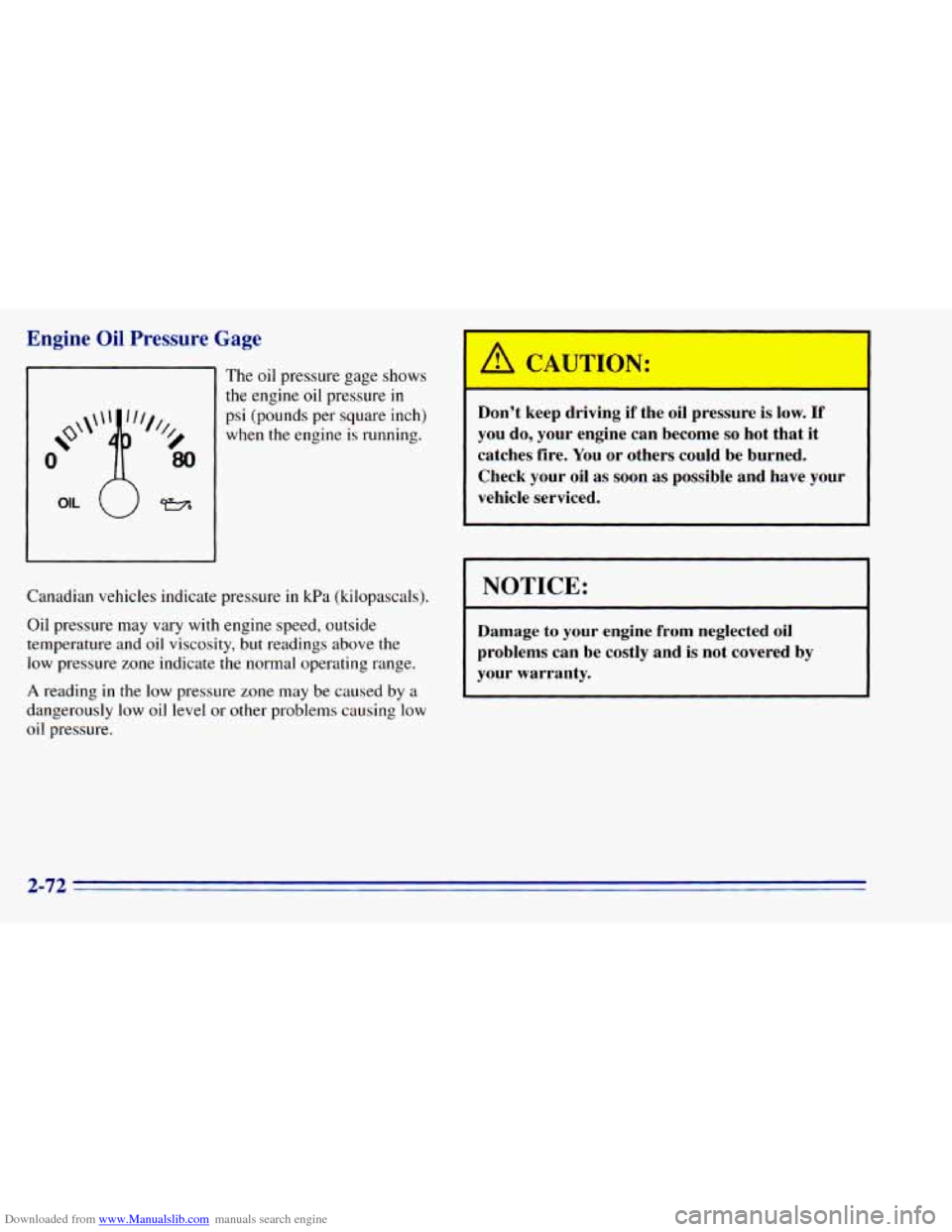
Downloaded from www.Manualslib.com manuals search engine Engine Oil Pressure Gage
OIL 0-
The oil pressure gage shows
the engine oil pressure in
psi (pounds per square inch)
when the engine
is running.
Canadian vehicles indicate pressure in kPa (kilopascals).
Oil pressure may vary with engine speed, outside
temperature
and oil viscosity, but readings above the
low pressure zone indicate the normal operating range.
A reading in the low pressure zone may be caused by a
dangerously
low oil level or other problems causing low
oil pressure.
CAUTION:
Don't keep driving if the oil pressure is low. If
you do, your engine can become so hot that it
catches fire. You or others could be burned.
Check your oil as soon as possible and have your
vehicle serviced.
NOTICE:
Damage to your engine from neglected oil
problems can be costly and is not covered by
your warranty.
2-72
Page 257 of 392
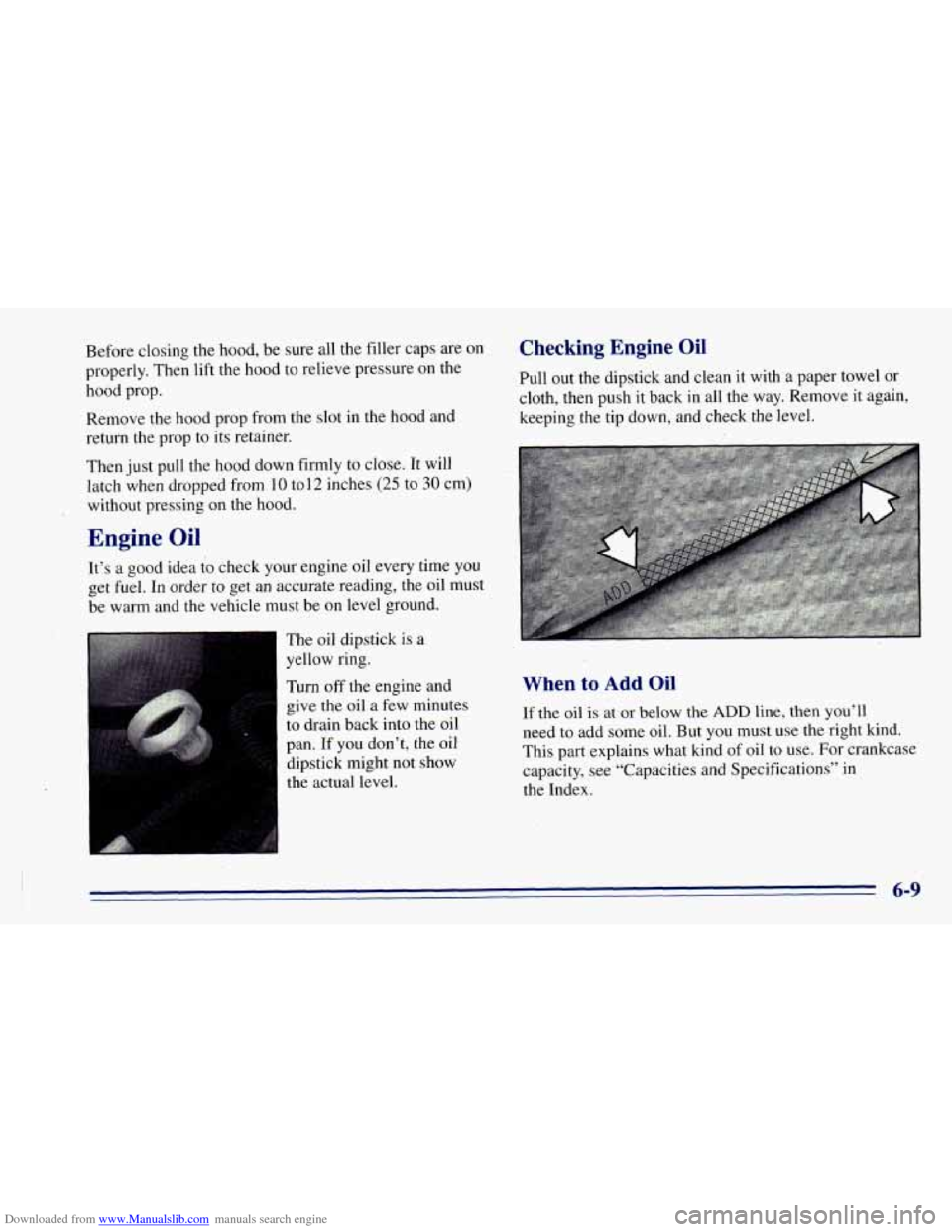
Downloaded from www.Manualslib.com manuals search engine Before closing the hood, be sure all the filler caps are on
properly. Then lift the hood
to relieve pressure on the
hood prop.
Remove the hood prop
from the slot in the hood and
return the prop to
its retainer.
Then just pull the hood down firmly
to close. It will
latch when dropped from
10 to12 inches (25 to 30 cm)
without pressing
on the hood.
Engine Oil
It’s a good idea to check your engine oil every time you
get fuel. In order to get an accurate reading, the oil must
be warm and the vehicle must be on level ground.
The oil dipstick is
a
yellow ring.
Turn
off the engine and
give the oil a few minutes
to drain back into the oil
pan.
If you don’t, the oil
dipstick might not show
the actual level.
Checking Engine Oil
Pull out the dipstick and clean it with a paper towel or,
cloth, then push it back in all the way. Remove it again,
keeping the tip down, and check the level.
When to Add Oil
If the oil is at or below the ADD line, then you’ll
need to add some oil. But you must use the right kind.
This part explains what kind of
oil to use. For crankcase
capacity, see “Capacities and Specifications” in
the Index.
6-9
Page 298 of 392
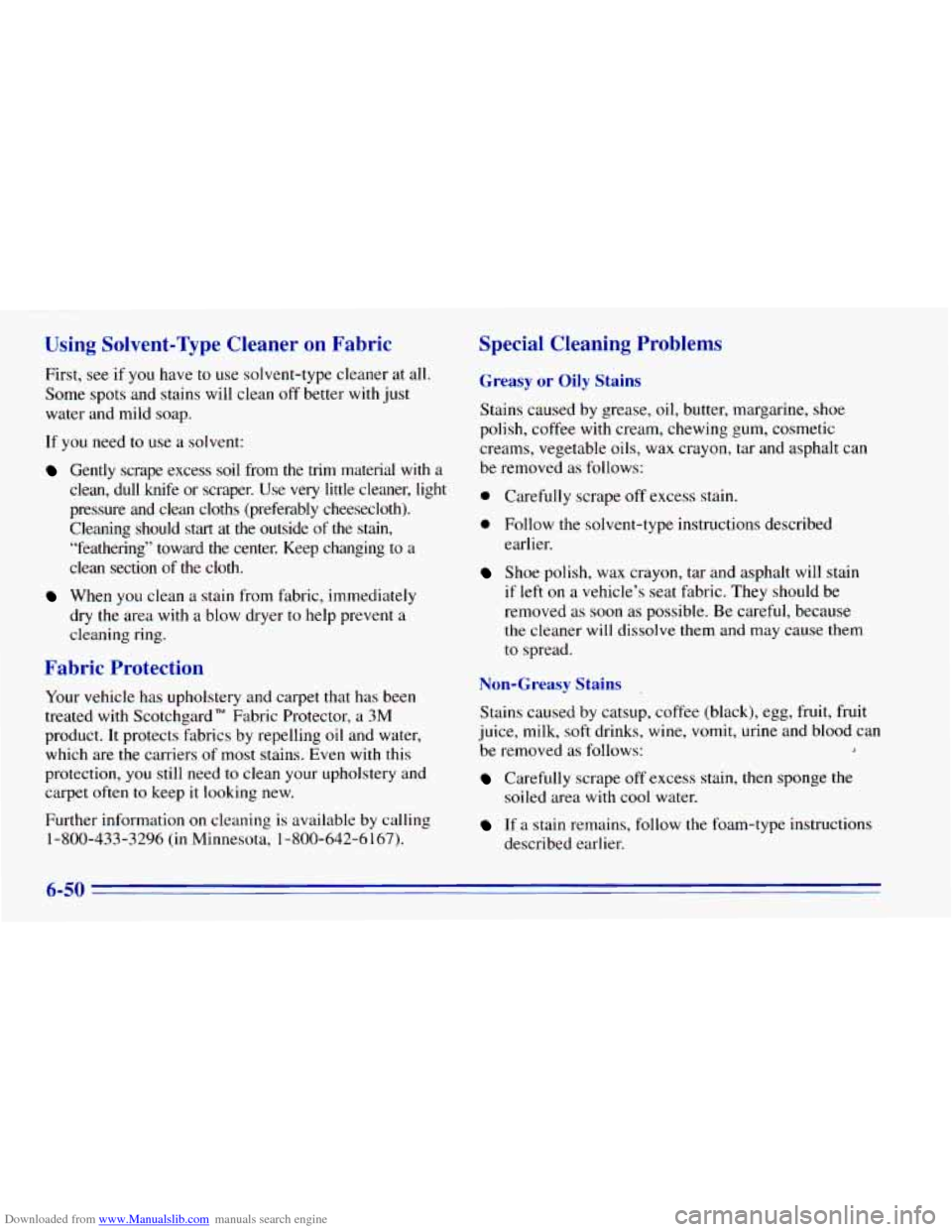
Downloaded from www.Manualslib.com manuals search engine Using Solvent-Type Cleaner on Fabric
First, see if you have to use solvent-type cleaner at all.
Some spots and stains will clean off better with just
water and mild soap.
If
you need to use a solvent:
Gently scrape excess soil from the trim material with a
clean, dull knife or scraper. Use very little cleaner, light
pressure
and clean cloths (preferably cheesecloth).
Cleaning should start at the outside of the stain,
.. “featheri-ng” tgward the center. Keep changing to a
clean section
of the cloth.
When you clean a stain from tdbric, immediately
dry the area with a blow dryer
to help prevent a
cleaning ring.
Fabric Protection
Your vehicle has upholstery and carpet that has been
treated with Scotchgard” Fabric Protector, a
3M
product. It protects fabrics by repelling oil and water,
which are
the carriers of most stains. Even with this
protection,
you still need to clean your upholstery and
carpet often
to keep it looking new.
Further information
on cleaning is available by calling
1-800-433-3296 (in Minnesota, 1-800-642-6 167).
Special Cleaning Problems
Greasy or Oily Stains
Stains caused by grease, oil, butter, margarine, shoe
polish, coffee with cream, chewing gum, cosmetic
creams, vegetable oils, wax crayon, tar and asphalt can
be removed as follows:
0 Carefully scrape off excess stain.
0 Follow the solvent-type instructions described
earlier.
Shoe polish, wax crayon, tar and asphalt will stain
if left on a vehicle’s seat fabric. They should be
removed as soon as possible. Be careful, because
the cleaner will dissolve them and may cause them
to spread.
Non-Greasy Stains
Stains caused by catsup, coffee (black), egg, fruit, fruit
juice, milk, soft drinks, wine, vomit, urine and blood can
be removed as follows:
J
Carefully scrape off excess stain, then sponge the
soiled area
with cool water.
If a stain remains, follow the foam-type instructions
described earlier.
6-50
Page 301 of 392
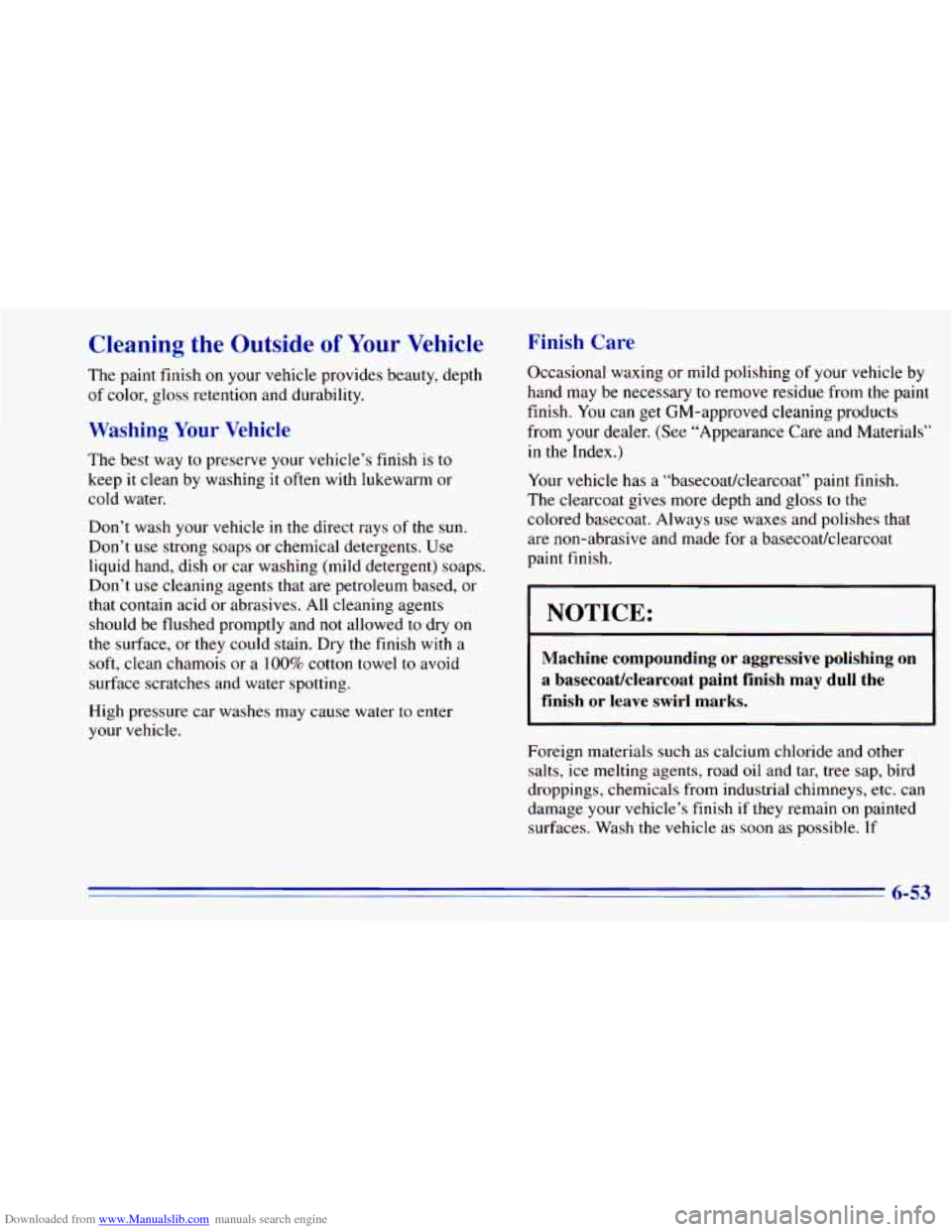
Downloaded from www.Manualslib.com manuals search engine Cleaning the Outside of Your Vehicle
The paint finish on your vehicle provides beauty, depth
of color, gloss retention and durability.
Washing Your Vehicle
The best way to preserve your vehicle’s finish is to
keep it clean by washing it often with lukewarm or
cold water.
Don’t wash your vehicle in the direct rays of the sun.
Don’t
use strong soaps or chemical detergents. Use
liquid hand, dish or car washing (mild detergent) soaps.
Don’t use cleaning agents that are petroleum based, or
that contain acid or abrasives. All cleaning agents
should be flushed promptly and not allowed to dry on
the surface, or they could stain. Dry the finish
with a
soft, clean chamois or a
100% cotton towel to avoid
surface scratches and water spotting.
High pressure car washes may cause water to enter
your vehicle.
Finish Care
Occasional waxing or mild polishing of your vehicle by
hand may be necessary
to remove residue from the paint
finish. You can get GM-approved cleaning products
from your dealer. (See “Appearance Care
and Materials’’
in the Index.),
Your vehicle
has a “basecoatklearcoat” paint finish.
The clearcoat gives more depth
and gloss to the
colored basecoat. Always use waxes and polishes that
are non-abrasive and made for a basecoatklearcoat
paint finish.
I NOTICE:
Machine compounding or aggressive polishing on
a basecoatklearcoat paint finish may
dull the
finish or leave swirl marks.
Foreign materials such as calcium chloride and other
salts, ice melting agents, road oil and tar, tree sap, bird
droppings, chemicals from industrial chimneys, etc. can
damage your vehicle’s finish
if they remain on painted
surfaces. Wash the vehicle as soon as possible.
If
6-53
Page 359 of 392
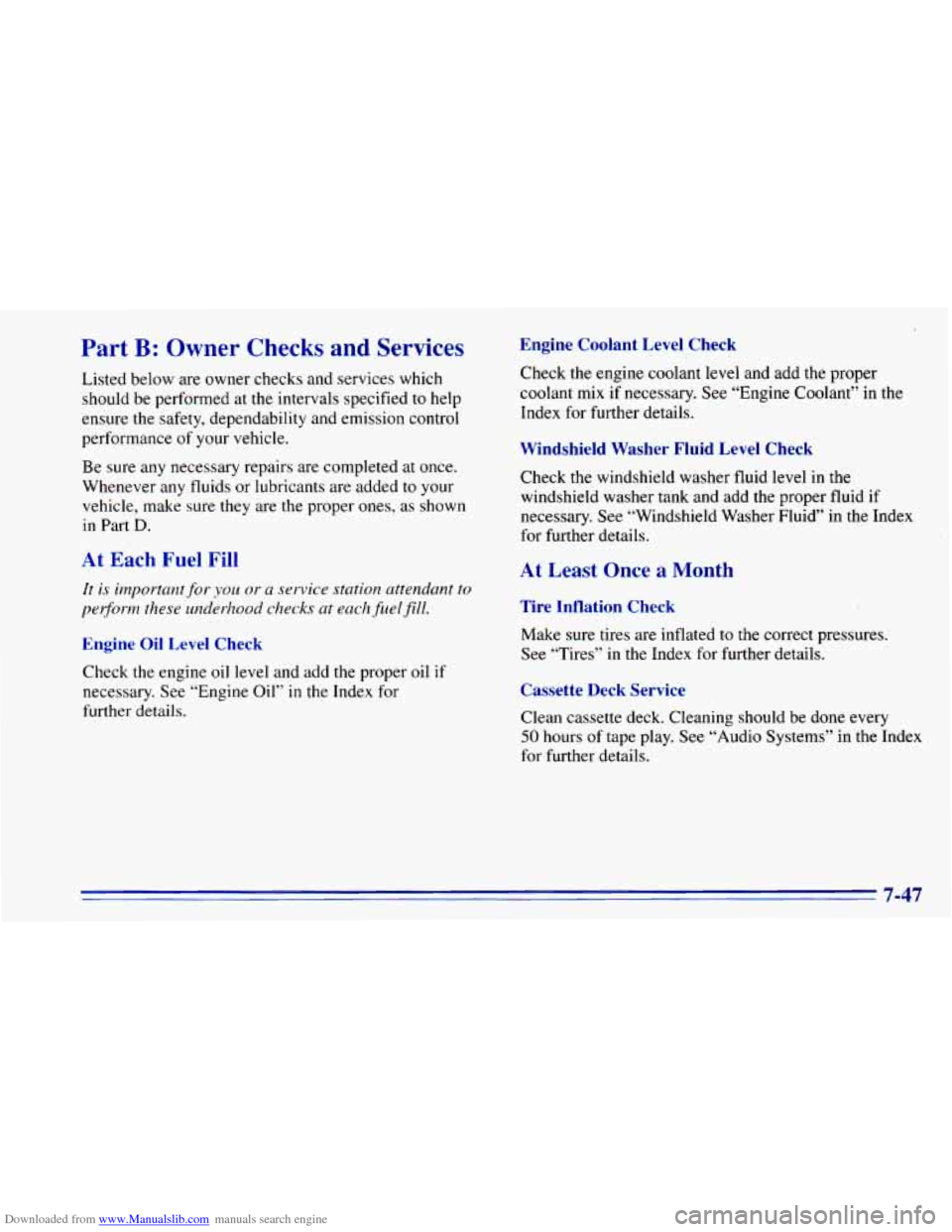
Downloaded from www.Manualslib.com manuals search engine Part B: Owner Checks and Services
Listed below are owner checks and services which
should be performed at the intervals specified to help
ensure the safety, dependability and emission control
performance of your vehicle.
Be sure any necessary repairs are completed at once.
Whenever any fluids or lubricants are added to your
vehicle, make sure they are the proper ones, as shown
in Part D.
At Each Fuel Fill
It is important for you or a service station attendant to
perform these underhood checks
at each fuel fill.
Engine Oil Level Check
Check the engine oil level and add the proper oil if
necessary. See “Engine Oil” in the Index for
further details.
Engine Coolant Level Check
Check the engine coolant level and add the proper
coolant mix if necessary. See “Engine Coolant” in the
Index for further details.
Windshield Washer Fluid Level Check
Check the windshield washer fluid level in the
windshield washer tank and add the proper fluid if
necessary. See “Windshield Washer Fluid” in the Index
for further details.
At Least Once a Month
Tire Inflation Check
Make sure tires are inflated to the correct pressures.
See “Tires”
in the Index for further details.
Cassette Deck Service
Clean ca :tte deck. Cleaning should be done every
50 hours or tape play. See “Audio Systems” in the Index
for further details.
7-47
Page 384 of 392
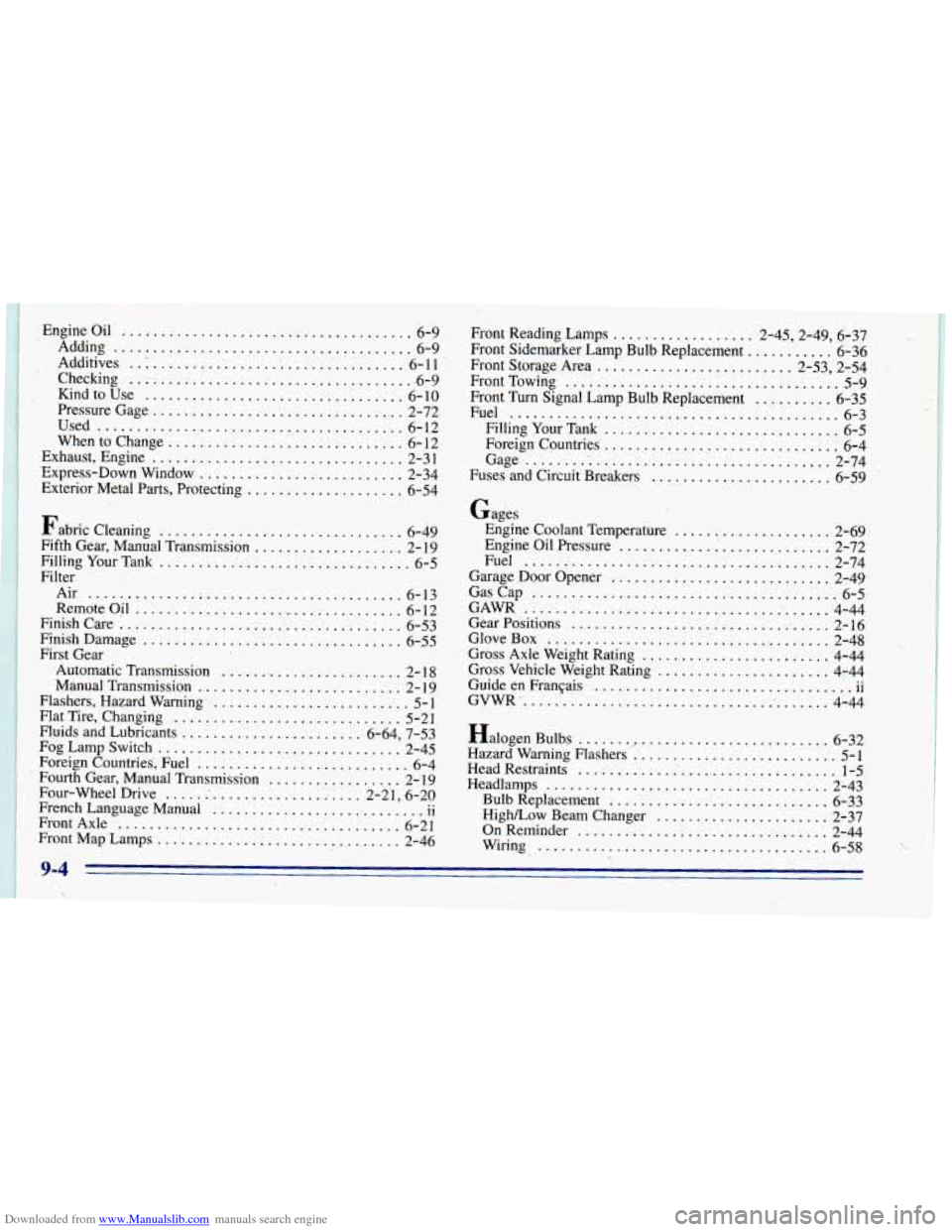
Downloaded from www.Manualslib.com manuals search engine Engine Oil ..................................... 6-9
Adding 6-9
Additives
.. ................................. 6-1 1 .
. Checking ..................................... -6-9
Kind to Use 6-10
Pressure Gage 2-72
Whentochange
.............................. 6-12
Exhaust. Engine
................................ 2-31
.......................................
.................................
................................
Used ....................................... 6-12
'Express-Down Window
.......................... 2-34
Exterior Metal Parts. Protecting
.................... 6-54
Fabric Cleaning
............................... 6-49
Fifth Gear. Manual Transmission
................... 2- 19
Filling Your Tank
................................. 6-5
Filter
Air
........................................ 6-13
Remote Oil
................................... 6- 12
Finishcare
........ ............................ 6-53
Finish Damage ................................. 6-55
Flashers. Hazard Warning
......................... 5-1
Flat Tire. Changing
............................. 5-21
Fluids and Lubricants
....................... 6-64. 7-53
Fog Lamp Switch
............................... 2-45
Foreign Countries. Fuel
........................... 6-4
. Fourth Gear. Manual Transmission ................. 2- 19
Front Map'Lamps
............................... 2-46
First Gear
Automatic Transmission
........................ 2- 18
Manual Transmission
........................... 2- 19
Four-wheel Drive
.......................... 2-21. 6-20
French Language Manual
11
FrontAxle ..................................... 6-21
.. ............................
Front Reading Lamps ............... .. .. 2.45.2.49. 6.37
Front Storage Area
.......................... 2-53. 2-54
Front Towing 5-9
Fuel
........................................... 6-3
Front Sidemarker
Lamp Bulb Replacement
........... 6-36
Front Turn Signal Lamp Bulb Replacement
.. ., ....... 6-35
Filling Your Tank
.............................. 6-5
Foreign Countries
.............................. 6-4
Fuses and Circuit Breakers
....................... 6-59
...................................
Gage ....................................... 2-74
Gages Engine Coolant Temperature
.................... 2-69
Engine Oil Pressure
............................ 2-72
Fuel
....................................... 2-74
Garage Door Opener
............................. . 2-49
GasCap
........................................ .. 6-5
Gear Positions
.................................. 2-16
GloveBox
.................................... 2-48
GAWR
........................................ 4-44
Gross Axle Weight Rating
........................ 4-44
Gross Vehicle Weight Rating
...................... 4-44
Guide en Frangais
1 11 .. ............................... .
GWR' ........................................ 4-44
Halogen Bulbs
...... ., ........................ 6-32
Hazard Warning Flashers'
.' ......................... 5-1
High/Low Beam Changer ...................... 2-37
Head Restraints
.................................. 1-5
Headlamps .................................... 2-43
Bulb Replacement
............................. 6-33
OnReminder
................................ 2-44
Wiring
..................................... 6-58
9-4